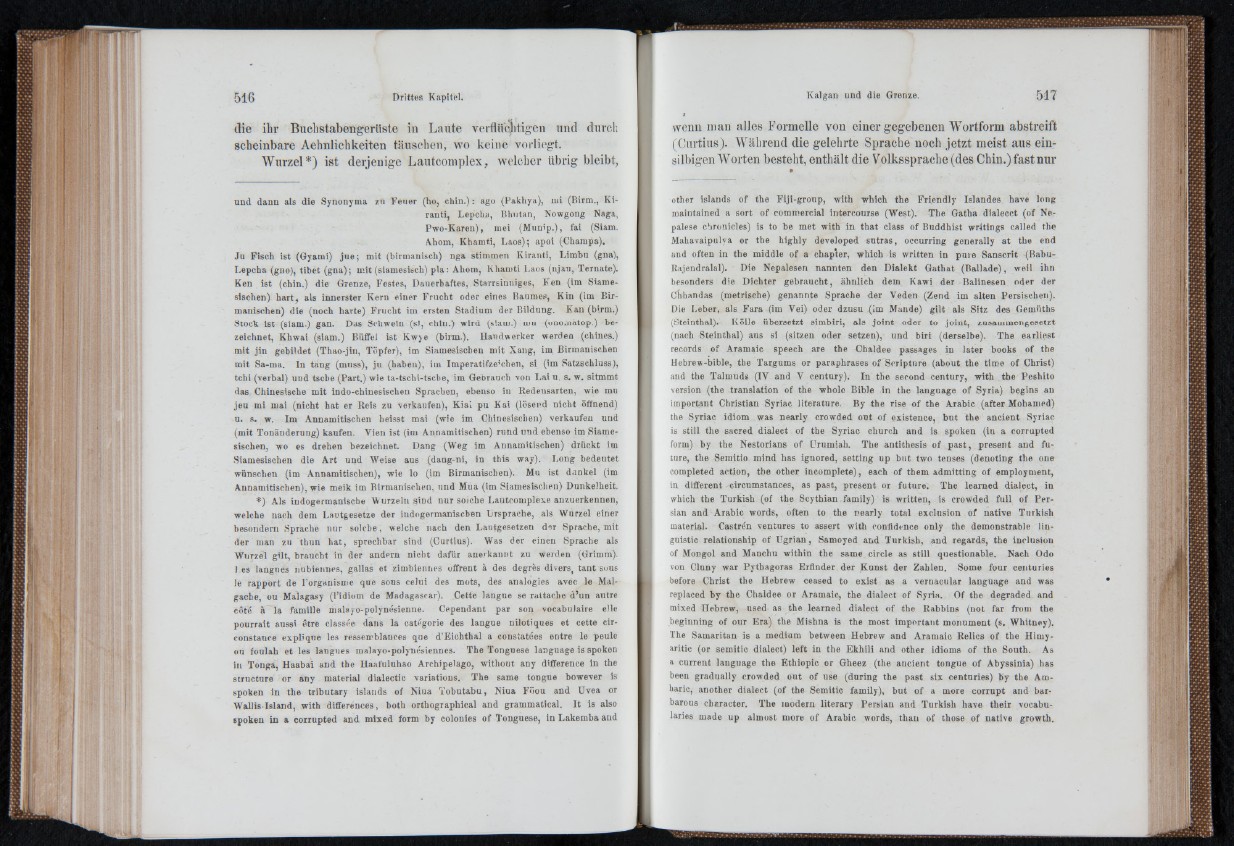
die ihr Buchstabengerttste in Laute verflüchtigen und durch
scheinbare Aehnlichkeiten täuschen, wo keine vorliegt.
Wurzel*) ist derjenige Lautcomplex, welcher übrig bleibt,
und dann als die Synonyma zn Feuer (ho, chin.) : ago (Pakhya), mi (Birm., Kiranti,
Lepcba, Bhiitan, Nowgong Naga,
Pwo-Karen), mei (Munip.), fai (Siam.
Ahom, Khamti, Laos); apoi (Champa),
Jn Fisch ist (Gyami) ju e ; mit (birmanisch) nga stimmen Kiranti, Limbu (gna),
Lepcha (gno), tibet (gna); mit (siamesisch) pla: Ahom, Khamti Laos (njan, Ternate).
Ken ist (chin.) die Grenze, Festes, Dauerhaftes,. Starrsinniges, Ken (im Siamesischen)
h a rt, als innerster Kern einer Frucht oder eines Baumes, Kin (im Birmanischen)
die (noch harte) Frucht im ersten Stadium der Bildung. Kan (birm.)
Stock ist (siam.) gan. Das Schwein (si, chin.) wird (siam.) mu (onojiatop.) bezeichnet,
Khwai (siam.) Büffel ist Kwye (birm.). Handwerker werden (chines.)
mit jin gebildet (Thao-jin, Töpfer), im Siamesischen mit Xang, im Birmanischen
mit Sa-ma. In täng (mnss), ju (haben), im Imperatifzemhen, si (im Satzschluss),
tchi (verbal) und tscbe (Part.) wie ta-tschi-tscbe, im Gebrauch vou Lai u. s. w. sitmmt
das. Chinesische mit indo-chinesischen Sprachen, ebenso in Redensarten, wie mu
jeu mi mai (nicht hat er Reis zu verkaufen), Kiai pu Kai (lösend nicht öffnend)
u. s. w. Im Aunamitischen beisst mai (wie im Qhinesiscben) verkaufen und
(mit Tonänderung) kaufen. Vien ist (im Annamitischen) rund und ebenso im Siamesischen,
wo es drehen bezeichnet. Dang (Weg im Annamitischen) drückt im
Siamesischen die Art und Weise aus (dang-ni, in this way). Long bedeutet
wünschen (im Annamitischen), wie io (im Birmanischen). Mu ist dunkel (im
Annamitischen), wie meik im Birmanischen, und Mua (im Siamesischen) Dunkelheit.
*) Als indogermanische Wurzeln sind nur sojche Lautcomplexe anzuerkennen,
welche nach dem Lautgesetze der indogermanischen Ursprache, als Wurzel einer
besondern Sprache nur solche, welche nach den Lautgesetzen der Sprache, mit
der man zu thun h a t, sprechbar sind (Curtius). Was der einen Sprache als
Wurzel gilt, braucht in der ändern nicht dafür anerkannt zu werden (Grimm).
I es langues nubiennes, gallas et zimbiennes offrent à des degrés divers, tant sons
le rapport de l’organisme que sons celui des mots, des analogies avec le Malgache,
ou Malagasy (l’idiom de Madagascar). Cette langue se rattache d’un autre
côté à~ la famille malayo-polynésienne. Cependant par son vocabulaire elle
pourrait aussi être classée dans la catégorie des langue nilotiques et cette circonstance
explique les ressemblances que d’EiChthal a constatées entre le peule
on foulah et les langues malayo-polynésiennes. The Tonguese language is spoken
in Tonga, Haabai and the Haat'uluhao Archipelago, without any difference in the
structure or any material dialectic variations. The same tongue however is
spoken in the tributary islands of Nina Tobutabu, Niua Föou and Uvea or
Wallis-Island, with differences, both orthographical and grammatical. I t is also
spoken in a corrupted and mixed form by colonies of Tonguese, in Lakemba and
wenn man alles Formelle von einer gegebenen Wortform abstreift
(Curtius). Während die gelehrte Sprache noch jetzt meist aus einsilbigen
Worten besteht, enthält die Volkssprache (des Chin.) fast nur
other islands of the Fiji-group, with which the Friendly Islandés have long
maintained a sort of commercial intercourse (West). The Gatha dialecct (of Nepalese
chronicles) is to be met with in th at class of Buddhist writings called the
Mahavaipulya or the highly developed sntras, occurring generally at the end
and often in the middle of a chapter, which is written in pure Sanscrit {Babu-
Rajendralal). Die Nepalesen nannten den Dialekt Gathat (Ballade), weil ihn
besonders die Dichter gebraucht, ähnlich dem Kawi der Balinesen oder der
Chhandas (metrische) genannte Sprache der Veden (Zend im alten Persischen).
Die Leber, als Fara (im Vei) oder dzusu (im Mande) gilt als Sitz des Gemiiths
(Steinthal). Kölle übersetzt simbiri, als joint oder to joint, zusammengesetzt
(nach Steintbal) aus si (sitzen oder setzen), und biri (derselbe). The earliest
records of Aramaic speech are the Chaldee passages in later books of the
Hebrew-bible, the Targums or paraphrases of Scripture (about the time of Christ)
and the Talmuds (IV and V century). In the second century, with the Peshito
version (the translation of the wholo Bible in the language of Syria) begins an
important Christian Syriac literature. By the rise of the Arabic (after Mohamed)
the Syriac idiom was nearly crowded out of existence, bn t the ancient Syriac
is still the sacred dialect of the Syriac church and is spoken (in a corrupted
form) by the Nestorians of Drumiah. The antithesis of p a s t, present and future,
the Semitio mind has ignored, setting up but two tenses (denoting the one
completed action, the other incomplete), each of them admitting of employment,
in different -circumstances, as past, present or future. The learned dialect, in
which the Turkish (of the Scythian family) is written, is crowded full of Pe rsian
and Arabic words, often to the nearly total exclusion of native Turkish
material. Castrén ventures to assert with confidence only the demonstrable linguistic
relationship of Ugrian, Samoyed and Turkish, and regards, the inclusion
of Mongol and Manchu within the same circle as still questionable. Nach Odo
von Cluny war Pythagoras Erfinder der Kunst der Zahlen. Some four centuries
before Christ the Hebrew ceased to exist as a vernacular language and was
replaced by the Chaldee or Aramaic, the dialect of Syria. Of the degraded and
mixed Hebrew, used as the learned dialect of the Rabbins (not far from the
beginning of our Era) the Mishna is the most important monument (s. Whitney).
The Samaritan is a medium between Hebrew and Aramaic Relics of the Himy-
aritic (or Semitic dialect) left in the Ekhili and other idioms of the South. As
a current language the Ethiopic or Gheez (the ancient tongue of Abyssinia) has
been gradually crowded ont of use (during the past six centuries) by the Am-
haric, another dialect (of the Semitic family), but of a more corrnpt and barbarous
character. The modern literary Persian and Turkish have their vocabularies
made up almost more of Arabic words, than of those of native growth.